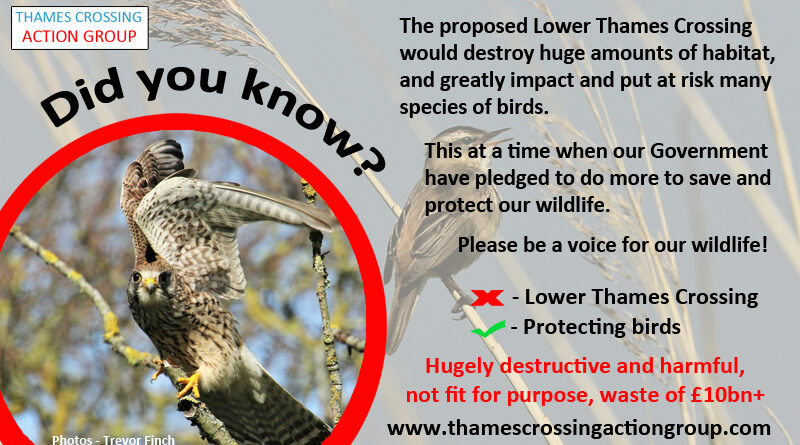LTC impacts on birds
The proposed Lower Thames Crossing would destroy the habitat (trees, hedgerows, fields, marshes etc) of birds, as well as negatively impacting their food chain (bugs and creatures), and create noise, light, air, water pollution that would impact them too. Plus of course there is the issue of birds being hit by vehicles. It’s not just local birds at risk either, we have many birds that visit or stop over in the area as part of migration routes.
We know there are many amazing species of birds that would be negatively impacted if the proposed LTC goes ahead, like red kite, hen harrier, marsh harrier, short-eared owl, buzzard, peregrine falcon, sparrow hawks, barn owls, tawny owls, ruff, common tern, avocet, golden plover, curlew, cuckoo, skylark, Cetti’s warbler, woodpeckers, meadow pippets and so many more. We’ve even heard that a white tailed eagle, and a Gyro falcon have been spotted in the Thurrock area!
Habitat loss and impacts
Woodlands, including ancient woodland, and hedgerows that are home to many species would be lost and impacted. Mudflats and salt marshes along the Thames are considered to be Nationally significant habits. Much of the development boundary is agricultural land which again is home to many species, including some ground nesting birds.
Impacts in development
The Forestry Commission previously bought the land at Jeskyn’s in Kent to turn it into a community woodland. Much of the land was arable crops that would usually be harvested by the farmer after the young skylarks had left their nests, along with Corn Buntings and Meadow Pipets. All are classed as “red species” by the Royal Society for the Protection of Birds – the highest conservation priority because of their rapid decline in recent years.
However, teams of tractors were moved in by the Forestry Commission/Government and ploughed up the fields before around 60 nests full of newly-born skylarks and their eggs had grown and flown the nest. Conservationists fear that all of the birds are dead, killed as they nested. Evidently a liberal spraying of super-strength pesticide had also ensured that they and other forms of wildlife did not come back.
A Forestry Commission spokesman later admitted that the ploughing was an “operational misjudgement which we regret”. “We certainly had no intention of harming any birds,” he said. “We have commissioned an ornithologist to advise us on the way forward.”
This just goes to show the terrible things that can happen with projects, even when the developer is supposed to have expert knowledge and be taking best steps to ensure safety and protection for our natural environment.
The East Atlantic Flyway
A migratory route for birds that stretches from The Humber to the North down to the Thames to the South, the East Atlantic Flyway is one of eight superhighways for birds globally. The proposed LTC would impact the southern section of the Flyway. The Thames Estuary and Marshes are important safe havens for migratory and local birds.
Noise pollution
We talk to each other to communicate, birds chirp and sing songs. They rely on this to communicate and warn each other of danger/predators etc. Ever notice how birds stop singing as you walk through a woodland or by trees? But if you sit quietly they begin to chirp again. So in areas with a lot of noise pollution it has a big negative impact on wildlife, including birds. They are less able to communicate and warn each other, and so they don’t thrive in areas with noise pollution.
Light pollution
Some birds are nocturnal, meaning they are active at night time in the dark, so light pollution from roads can be an issue, and have a negative impact.
Soil pollution
Pollution from roads gets into the soil, and that in turn has a negative impact on habits and other creatures that birds feed on. It can also negatively impact the plants and trees that birds use for nesting and roosting.
Water pollution
Not only do birds drink water, but many feed on fish and marine life. If the water is polluted this impacts the creatures in the water, and those that drink and eat from the water sources (estuary, rivers, watercourses, ponds etc).
Air pollution
Just as polluted air has a negative impact on our health, so does it negatively impact other creatures including birds.
Road kill risk
Research shows that 194 million birds are killed on European roads.
Proposing to put such a huge road project through areas that are currently home to so many native and visiting migratory birds would have a negative impact on birds. As a country that is one of the most nature depleted in the world, we need to be saving and protecting nature, not building destructive and harmful roads like the proposed LTC.
If you want to learn more about bird species check out the RSPB’s handy A-Z of birds!
Related
LTC impacts to wildlife – click here
LTC impacts to woodland – click here
RSPB – Lower Thames Crossing – click here
The Guardian – UK bird numbers continue to crash… (April 2023) – click here

